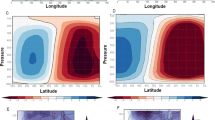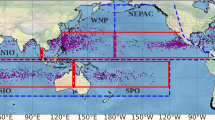Abstract
The cyclone phase space (CPS) method has been utilized to evaluate the extratropical transition (ET) of tropical cyclones (TCs) in many recent publications. However, these studies mainly focused over the North Atlantic basin. In this paper, the CPS characteristics of all the cyclones over the western North Pacific are investigated and discussed, with three parameters calculated from the best-track data of the Regional Specialized Meteorological Center in Tokyo and the Japanese 25-yr reanalysis data. It is concluded that most TCs over the western North Pacific possess the non-frontal and warm-core structure, while a larger number of cyclones that have undergone ET hold the frontal and cold-core structure. The spatial pattern of the CPS parameters indicates that the areas of tropical and extratropical cyclone activities could be demarcated by 30°N. The composite and individual series of three parameters of the CPS indicate that the transformation of −V UT from positive to negative leads to the start of ET, and could be considered as a potential predictor in operationally forecasting an ET event.
Similar content being viewed by others
References
Arnott, J. M., and J. L. Evans, 2004: Characterization of extratropical transition using cluster analysis. Mon. Wea. Rev., 132, 2916–2937.
Emanuel, K., 2008: The hurricane-climate connection. Bull. Amer. Meteor. Soc., 89, 10–20.
Evans, J. L., and R. E. Hart, 2003: Objective indicators of the life cycle evolution of extratropical transition for Atlantic tropical cyclones. Mon. Wea. Rev., 131, 909–925.
—, and J. M. Arnott, 2006: Evaluation of operational model cyclone structure forecasts during extratropical transition. Mon. Wea. Rev., 134, 3054–3072.
Hanssen, A. W., and W. J. A. Kuipers, 1965: On the relationship between the frequency of rain and various meteorological parameters. Koninklijk Nederlands Meteorologisch Institut, Meded. Verhand., 81, 2–15.
Harr, P. A., and R. L. Elsberry, 2000: Extratropical transition of tropical cyclones over the western North Pacific. Part I: Evolution of structural characteristics during the transition process. Mon. Wea. Rev., 128, 2613–2633.
—, —, and T. F. Hogan, 2000: Extratropical transition of tropical cyclones over the western North Pacific. Part II: The impact of midlatitude circulation characteristics. Mon. Wea. Rev., 128, 2634–2653.
Hart, R. E., 2003: A cyclone phase space derived from thermal wind and thermal asymmetry. Mon. Wea. Rev., 131, 585–616.
—, J. L. Evans, and C. Evans, 2006: Synoptic composites of the extratropical transition life cycle of North Atlantic tropical cyclones: Factors determining post transition evolution. Mon. Wea. Rev., 134, 553–578.
Hatsushika, H., J. Tsutsui, M. Fiorino, and K. Onogi, 2006: Impact of wind profile retrievals on the analysis of tropical cyclones in the JRA-25 reanalysis. J. Meteor. Soc. Japan, 84, 891–905.
Japan Meteorological Agency (JMA), 1990: Manual of the Operational Forecasting of Tropical Cyclones. Japan Meteorological Agency, 150 pp. (in Japanese)
Jones, S. C., and Coauthors, 2003: The extratropical transition of tropical cyclones: Forecast challenges, current understanding, and future direction. Wea. Forecasting, 18, 1052–1092.
Kitabatake, N., 2008: Extratropical transition of tropical cyclones in the western North Pacific: Their frontal evolution. Mon. Wea. Rev., 136, 2066–2090.
Klein, P. M., P. A. Harr, and R. L. Elsberry, 2000: Extratropical transition of western North Pacific tropical cyclones: An overview and conceptual model of the transformation stage. Wea. Forecasting, 15, 373–396.
Li Ying, Chen Lianshou, and Lei Xiaotu, 2005: Moisture potential vorticity analysis on the extratropical transition processes of Winnie (1997) and Bilis (2000). J. Tropical Meteor., 21, 142–152. (in Chinese)
Matano, H., and M. Sekioka, 1971: Some aspects of extratropical transformation of a tropical cyclone. J. Meteor. Soc. Japan, 49, 736–743.
Onogi, K., and Coauthors, 2007: The JRA-25 reanalysis. J. Meteor. Soc. Japan, 85, 369–432.
Pratt, A. S., and J. L. Evans, 2009: Potential impacts of the Saharan air layer on numerical model forecasts of North Atlantic tropical cyclogenesis. Wea. Forecasting, 24, 420–435.
Sekioka, M., 1956: A hypothesis on complex of tropical and extratropical cyclones for typhoon in middle latitude. Part I: Synoptic structure of Typhoon Marie over the Japan Sea. J. Meteor. Soc. Japan, 34, 42–53.
Veren, D., J. L. Evans, S. Jones, and F. Chiaromonte, 2009: Novel metrics for evaluation of ensemble forecasts of tropical cyclone structure. Mon. Wea. Rev., 137, 2830–2850.
Woodcock, F., 1976: The evaluation of yes/no forecasts for scientific and administrative purposes. Mon. Wea. Rev., 104, 1209–1214.
Zhang Yingxin, Zhang Shoubao, and Wang Fuxia, 2008: Application of an objective discriminating method in the evolution of tropical cyclone “Haima” during its extratropical transition. J. Tropical Meteor., 24(4), 341–348. (in Chinese)
Zhu, P., Y. Zheng, C. Zhang, and Z. Tao, 2005: A study of the extratropical transformation of Typhoon Winnie (1997). Adv. Atmos. Sci., 22, 730–740.
Author information
Authors and Affiliations
Corresponding author
Additional information
Supported by the National Natural Science Foundation of China under Grant Nos. 40830958 and 40730948, the “973” Program of China under Grant No. 2009CB421502, and the National Rescarch Fund for Public Welfare under Grant Nos. GYHY200906011 and GYHY201006007.
Rights and permissions
About this article
Cite this article
Song, J., Han, J. & Wang, Y. Cyclone phase space characteristics of the extratropical transitioning tropical cyclones over the western North Pacific. Acta Meteorol Sin 25, 78–90 (2011). https://doi.org/10.1007/s13351-011-0006-y
Received:
Accepted:
Published:
Issue Date:
DOI: https://doi.org/10.1007/s13351-011-0006-y




